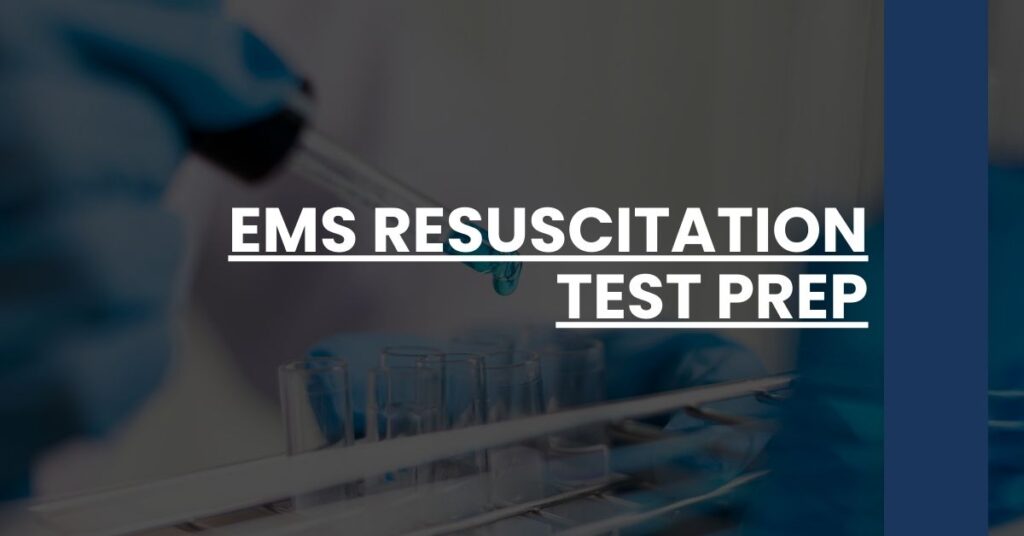EMS Resuscitation test prep is your gateway to excelling in life-saving techniques.
- Critical Protocols: Master essential resuscitation protocols for comprehensive emergency responses.
- Scenario Practice: Enhance skills through realistic simulations mirroring on-the-job challenges.
- Latest Guidelines: Stay abreast of the most up-to-date practices in EMS resuscitation.
Achieve excellence in EMS Resuscitation test prep with these focus areas.
- Understanding the EMS Resuscitation Exam
- Key Topics Covered in EMS Resuscitation Tests
- Study Materials for EMS Resuscitation Test Prep
- Creating an Effective Study Plan
- Practical Skills and Scenario-Based Practice
- Test-Taking Strategies for EMS Resuscitation
- The Role of Simulation in Test Prep
- Managing Test Anxiety and Staying Motivated
- Utilizing Review Courses and Workshops
- Staying Updated with Current Guidelines
- Leveraging Peer Support and Study Groups
- Conclusion: Next Steps After Test Prep
Understanding the EMS Resuscitation Exam
As you embark on your journey to become a respected Emergency Medical Services (EMS) professional, mastering the critical skills of resuscitation becomes a pivotal part of your education and training. The EMS Resuscitation exam—a formidable challenge standing between you and your commitment to saving lives—is designed to rigorously test your knowledge and capacity to perform under pressure.
Why is the EMS Resuscitation Exam Important?
It’s important to understand that the EMS Resuscitation exam assesses more than just your ability to remember procedures. It gauges your understanding of the underlying principles and your aptitude to apply them efficiently in real-time scenarios. The exam covers a breadth of competencies that include:
- Anatomy and physiology: A solid grasp of the human body and its systems.
- Pathophysiology: Insight into how diseases affect normal physiology, particularly in life-threatening situations.
- Emergency pharmacology: Knowledge of drugs used during resuscitation.
- Cardiac life support protocols: Familiarity with updated guidelines prescribed by authoritative organizations like the American Heart Association.
By diving deep into these subjects, you reinforce your foundational base, which becomes the cornerstone of your ability to deliver critical emergency care.
Key Topics Covered in EMS Resuscitation Tests
Your EMS Resuscitation test prep begins with understanding the core topics within the scope of the examination. These generally include but are not limited to:
- Cardiopulmonary Resuscitation (CPR): Review of techniques and protocols for adult, pediatric, and infant resuscitation.
- Advanced Cardiac Life Support (ACLS): Understanding complex cardiovascular life support mechanisms for stabilizing and treating patients.
- Pediatric Advanced Life Support (PALS): Specialized knowledge for addressing the resuscitation needs of children and infants.
- Automated External Defibrillator (AED) usage: Competence in using this life-saving device effectively.
- Airway management: Critical skills for ensuring patients can breathe, including intubation techniques.
These key areas form the pillars of EMS Resuscitation and will be at the heart of your exam.
Study Materials for EMS Resuscitation Test Prep
To confidently walk into your EMS Resuscitation test, your study arsenal must be loaded with the best materials. Consider these resources your training ground:
- Comprehensive textbooks: Titles like ‘Emergency Care and Transportation of the Sick and Injured’ offer a foundation for EMS education.
- Up-to-date online resources: Bookmark websites such as Emergency Medical Services for the latest developments in the field.
- Practice tests: Avail yourself of online databases with practice exams that mimic the real test ambiance.
Make these tools part of your everyday study routine, integrating them with hands-on practice to ensure a holistic preparation approach.
Creating an Effective Study Plan
An effective study plan for your EMS Resuscitation test prep is both a roadmap and a commitment device. It helps you navigate through the vast study materials and keeps you on track. Designing this study plan involves:
- Allocating time blocks: Dedicate specific hours of your day to each topic.
- Setting milestones: Break down the syllabus into attainable goals.
- Incorporating breaks: Ensure that you rest, as mental fatigue can hinder your absorption of information.
A structured study plan will become your steady companion, guiding you to stay focused and thorough in your test preparation.
Practical Skills and Scenario-Based Practice
Theory and knowledge are vital, but without the ability to translate them into action, they remain abstract concepts. The EMS Resuscitation exam will test your hands-on skills, so scenario-based practice is a must. Engage in:
- Mock resuscitation drills: Simulate real-life resuscitation scenarios.
- Practical workshops: A setting where you can refine your techniques under expert supervision.
- Peer review sessions: Collaborate with study partners to give and receive feedback.
These forms of practice will train your muscle memory and decision-making processes for the critical moments when they truly count.
Test-Taking Strategies for EMS Resuscitation
When it’s time to take the test, having a tactical approach can make all the difference. Here’s how to optimize your performance:
- Read the questions carefully: It’s crucial that you understand exactly what’s being asked before choosing an answer.
- Time management: Be aware of the clock and allocate your minutes wisely to ensure you have ample time to address all questions.
- Elimination techniques: Narrow down your choices by eliminating the obviously incorrect options.
Remember, the EMS Resuscitation test is as much a test of your stamina and nerves as it is of your knowledge, so go in with a plan and execute it with precision.
The Role of Simulation in Test Prep
In the dynamic world of emergency medical services, the ability to react effectively under high-pressure situations is as crucial as the theoretical knowledge one holds. Herein lies the power of simulation-based learning—it bridges the gap between what you learn from books and how you apply it in real emergencies.
Elevating Skills with High-Fidelity Simulations
- Real-World Experience: High-fidelity simulations offer an immersive environment that mimics real-life emergency scenarios. You learn to navigate the complexities of chaotic scenes without the risk of real-world consequences.
- Decision-Making Under Stress: By practicing in a simulated setting, you cultivate the ability to make quick, informed decisions—a skill of immeasurable value in the field of EMS.
Research has demonstrated that simulation training enhances CPR performance, instilling adherence to the guidelines that govern resuscitative efforts. These simulations not only hone your procedural skills but also reinforce the imperative cognitive aspects of EMS Resuscitation test prep.
The Impact of Technology in EMS Training
Simulation technology has evolved, now incorporating virtual reality (VR) and augmented reality (AR) to create hyper-realistic learning experiences. These tools allow you to:
- Engage in Safe Practice: Repeat procedures like intubation or defibrillation without risk to an actual patient.
- Receive Instant Feedback: Advanced simulation platforms provide real-time feedback, allowing you to correct mistakes and improve technique on the fly.
Managing Test Anxiety and Staying Motivated
As with any high-stakes examination, the EMS Resuscitation test brings its share of stress. However, it’s crucial to manage test anxiety to ensure it doesn’t undermine your performance. Here’s how you can keep nerves at bay and sustain your drive throughout your EMS Resuscitation test prep.
Strategies to Overcome Anxiety
- Structured Schedule: A well-organized study plan promises a sense of control over your preparation, thereby reducing anxiety.
- Mindfulness and Relaxation: Incorporate mindfulness exercises, such as deep breathing and meditation, into your daily routine to minimize stress levels.
Keeping the Motivation Alive
- Define Your Why: Remind yourself of why you chose a career in EMS—your motivation could be the wish to serve the community or a personal life-saving experience. This purpose can be a powerful motivator.
- Celebrate Small Victories: Acknowledge and reward every small study milestone. This positive reinforcement can boost your morale and keep the momentum going.
Utilizing these strategies can significantly mitigate test-related stress and help maintain the motivation critical for your test prep journey.
Utilizing Review Courses and Workshops
Enrolling in review courses and workshops is an effective way to complement your self-preparation. These structured programs offer several advantages:
- Expert Guidance: Instructors in specialized review courses can provide insights beyond textbooks, offering real-world expertise and test-taking strategies.
- Peer Interaction: You gain the opportunity to interact with fellow candidates, fostering a community of learning and support.
The Power of Collective Learning
Being part of a course or workshop means you can participate in group discussions, which can deepen your understanding and present different perspectives on EMS procedures.
Staying Updated with Current Guidelines
Medical protocols are not static; they evolve with ongoing research and technology advancement. Staying updated with the latest CPR and emergency cardiovascular care guidelines ensures that your EMS Resuscitation test prep is aligned with the best practices.
- Regular Review: Periodically review the latest AHA Guidelines for CPR & ECC, because these are frequently referenced in the EMS Resuscitation test.
- Incorporate Changes: Actively integrate updates into your practical skills and scenario-based training to reflect the most current standards.
The guidelines are your playbook for resuscitation; mastering them isn’t optional, it’s imperative.
Leveraging Peer Support and Study Groups
Study groups and peer support networks offer a collaborative approach to EMS Resuscitation test prep. Engaging with your peers can lead to:
- Shared Resources: Exchange study materials and tips that can enhance your preparation.
- Collective Problem-Solving: Discuss complex scenarios and questions, which can lead to a better understanding of challenging concepts.
The Benefits of Community Learning
Joining forces with peers presents the opportunity for mutual support, exchange of knowledge, and the chance to learn from the experiences of others. This sense of community can make the daunting preparation process much more approachable and less isolating.
Conclusion: Next Steps After Test Prep
Having explored the ins and outs of EMS Resuscitation test prep, you’re now equipped with the tools and techniques to tackle your examination with confidence. Your preparation doesn’t end here; it’s a continual process of learning, practicing, and staying abreast with the latest in emergency medical care. With diligence and dedication, your efforts will shape a career defined by the readiness to save lives and serve the community. Every study session, mock test, and simulation is a step toward becoming the proficient and compassionate EMS professional that you aspire to be.

